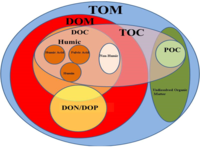
Photo from wikipedia
Understanding the microstructure of rhyolites may greatly promote exploration efforts on rhyolitic hydrocarbon reservoirs; however, related studies are sparse. In this contribution, the microstructure and related porosity of oil-bearing rhyolitic… Click to show full abstract
Understanding the microstructure of rhyolites may greatly promote exploration efforts on rhyolitic hydrocarbon reservoirs; however, related studies are sparse. In this contribution, the microstructure and related porosity of oil-bearing rhyolitic lavas from the Hailar Basin (NE China) were investigated using a combination of optical microscopy, fluorescence image analysis, and scanning electron microscopy. The direct visual and quantitative analyses show that the rhyolites are heterogeneous and porous rocks and have complex microstructures. Phenocryst-rich rhyolitic lava, perlitic lava, and spherulitic rhyolite may be favorable targets for rhyolitic hydrocarbon exploration. For the phenocryst-rich rhyolitic lavas, embayment pores, cleavages, cavitational and shear fractures, and intracrystalline sieve pores are commonly observed in the phenocrysts; while flow-parallel laminar and micropores are ubiquitous in the groundmass. Perlitic lavas are characterized by the occurrence of numerous perlitic fractures which can also be produced in the glassy groundmass of other lavas. Spherulitic rhyolites mainly consist of small-sized ( 1 mm) isolated spherulites. Clustered spherulites are characterized by the development of interspherulite pores. Isolated spherulites contain numerous radiating micropores. Both types of spherulites may have water expulsion pores formed in the spherulite–glass border. The formation of the microstructure and related porosity of rhyolites is controlled by pre-, syn- (e.g., deuteric crystal dissolution, cavitation, ductile–brittle deformation, and high-T devitrification), and post-volcanic (e.g., hydration and low-T devitrification) processes. Although pores with diameters > 50 μm are often observed, small pores dominate in pore-size distribution. Small ( 300 μm) pores give the most volumetric contribution in most cases. Medium-sized pores with diameters ranging from ~150–300 μm are the least developed and contribute the least to the total volume. The results of this paper can be beneficial to further the understanding of the microstructure and pore system of rhyolites and may be applied to rhyolitic lava hydrocarbon reservoirs elsewhere.
Journal Title: Minerals
Year Published: 2020
Link to full text (if available)
Share on Social Media: Sign Up to like & get
recommendations!